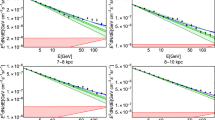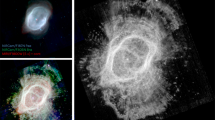Abstract
THERE is still the problem of the identification of galactic X-ray sources in the energy interval of 4–8 keV, and it seems reasonable to consider whether they can be identified with such common objects of the galactic disk as planetary nebulae. A planetary nebula is a slowly expanding gaseous shell with a very hot star inside, and in such a system X-ray emission could originate both in the nebula and in the star. We consider the nebula as a uniform spherical shell with a radius of ∼ 2 × 1017 cm and mass 0.1 M⊙; the radius of the central star can be taken as 1 R⊙ and its temperature as ≥2 × 105 °K (ref. 1). A value of 1 kpc seems a suitable characteristic distance.
This is a preview of subscription content, access via your institution
Access options
Subscribe to this journal
Receive 51 print issues and online access
$199.00 per year
only $3.90 per issue
Buy this article
- Purchase on SpringerLink
- Instant access to full article PDF
Prices may be subject to local taxes which are calculated during checkout
Similar content being viewed by others
References
Khromov, G. S., Mon. Not. Roy. Astro. Soc., 137, 181 (1967).
Pickelner, S. B., Sov. Astro. J., 44, 915 (1967).
Friedman, H., et al., Science, 156, 374 (1967).
Fisher, P., et al., Astrophys. J., 151, 1 (1968).
Perek, L., and Kohoutek, L., Catalogue of Galactic Planetary Nebulae (Prague, 1967).
Author information
Authors and Affiliations
Rights and permissions
About this article
Cite this article
KHROMOV, G. Planetary Nebulae as Possible X-ray Sources. Nature 220, 1111 (1968). https://doi.org/10.1038/2201111a0
Received:
Issue Date:
DOI: https://doi.org/10.1038/2201111a0



